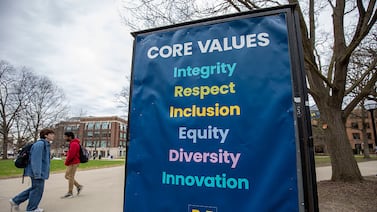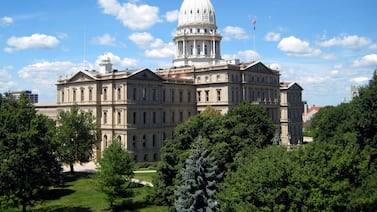After taking a 15% bite out of state education funding for next school year, the economic downturn caused by the coronavirus could eat another 9% of local school funding in the year after that, thanks to a complex Colorado tax law intended to protect homeowners but now straining businesses and rural areas.
Next school year’s hit stems from the immediate impacts of business closures, job losses, and historically low oil and gas prices. The revenue drop after that, as much as $490 million, would put a major strain on the state budget, as the current school funding system requires the state to backfill about half of those losses.
A bipartisan group of lawmakers wants to head off this property tax collapse by asking voters to repeal what’s known as the Gallagher Amendment. Doing so would also provide relief to small fire, library, and hospital taxing districts around the state. But the campaign likely will face an uphill battle in a state where voters have resisted major changes to tax policy — and in a year when many of them feel more economically squeezed than ever.
State Sen. Chris Hansen, a Denver Democrat and co-sponsor of the measure, said the message for voters is simple.
“In this time of crisis, we need to help the helpers and support our EMTs and our hospital districts and our teachers,” he said. “If we don’t change Gallagher, we’re going to have a massive erosion of the services we depend on.”
Repealing the Gallagher Amendment won’t raise property taxes, something proponents of repeal plan to emphasize, but leaving it on the books would keep homeowner taxes lower than they would be otherwise.
“I think what it comes down to is most Coloradans have seen their property taxes go up over the years, and their taxes will be higher without Gallagher than they would be with it,” said Michael Fields, executive director of the conservative group Colorado Rising State Action, who opposes the repeal. “So I think that’s going to be an uphill battle.”
To place a measure on the ballot, Colorado lawmakers first need to approve it by a two-thirds majority. Hansen and state Sen. Jack Tate, a Centennial Republican who is a co-sponsor, both think they’ll have little trouble persuading their colleagues to support repeal in the midst of a historic budget crisis. Gov. Jared Polis came out in support of the idea earlier this week.
Once placed on the ballot, the measure would need to pass by just 50% because it’s a repeal of a constitutional amendment, not the 55% necessary to add a new amendment to the state constitution.
In addition to a heated presidential election, the Gallagher repeal could share space on the ballot with numerous competing fiscal measures, including one to raise taxes on high earners, one to lower the state’s flat income tax, and one to require a vote of the people to approve major fee increases — all set amid the backdrop of an ongoing public health crisis.
Colorado voters approved the Gallagher Amendment in 1982. The amendment requires that residential property owners contribute no more than 45% of total property tax collections and that non-residential property — offices, shopping centers, farms, oil and gas fields, and so on — contribute the other 55%.
To achieve this balance, Colorado tinkers with the assessment rate, which determines the amount of property value that is actually taxable. As residential property values soared along the booming Front Range, the residential assessment rate has fallen from 21% in the early 1980s to just 7.15% this year to keep tax collections at 45% of the total.
The non-residential assessment rate remains fixed at 29% of a property’s assessed value. How much a property owner pays on that taxable value is determined by tax rates levied by local school districts, counties, and other taxing districts.
This has had a number of unintended consequences.
It’s dramatically shifted the state’s tax burden to businesses, a major reason that Tate wants to see it repealed, especially when so many business owners are struggling to stay afloat.
“Gallagher wasn’t necessarily about protecting homeowners but making sure businesses paid their fair share, but over 40 years, it’s transferred almost the entire tax liability to the business community,” he said. “If we don’t have functioning businesses and jobs, we don’t have tax revenue for anything.”
It’s also left many small, rural taxing districts that support hospitals, libraries, and fire departments struggling to provide basic services.
Gallagher sets assessment rates based on statewide averages. In urban and suburban communities, property values have risen so much that local governments still take in more revenue each year, even with less of that property value being taxable. These areas also have lots of businesses paying taxes as well.
But in rural communities with limited commercial property and low property values, the effect has been devastating.
“A lot of these fire districts and library districts in the metro area, most of them were not hurt, but when you get out into the eastern plains or the San Luis Valley, you’re decimating the tax base,” said Phyllis Resnick, executive director and lead economist of the Colorado Futures Center at Colorado State University. “And that disparity has gotten wider and wider.”
These districts could ask voters to increase property taxes, but that’s often a tough sell in communities with a limited tax base. It would take a big tax hike to generate much revenue.
In the case of schools, the effect has been tempered because the state makes up the difference where local tax dollars don’t cover base funding requirements. However, over time, this has contributed to the state shouldering a larger share of total K-12 costs and made it harder to pay for other state services.
Enter the coronavirus.
The measures taken to slow the spread of COVID-19 had an immediate impact on the sales and income taxes on which the state depends, leading to a $3.3 billion hole in the 2020-21 budget that lawmakers are working to pass now.
Economists don’t expect much impact on residential property tax values, but commercial property values are expected to plummet. To maintain that 55/45 ratio required by Gallagher, the state’s property tax administrator predicts the residential assessment rate will drop to 5.88%.
At today’s assessment rate, the owner of a $200,000 home would pay taxes on $14,300 of it, with the actual tax bill determined by local property tax rates. Under the new assessment rate, the same homeowner would pay taxes on just $11,760 of their home’s value. That’s good if you’re a cash-strapped homeowner, but bad if you’re a taxing entity.
For schools, that means the loss of $246 million in base property taxes for the fiscal year that starts July 1, 2021, plus the loss of another $244 million in voter-approved taxes that supplement base funding and pay for school construction debt.
Current law leaves the state on the hook for that first $246 million. That would be a hard blow to absorb in good times. With the economic impact of coronavirus expected to extend for several years, “that option is no longer available to us,” Hansen said. “The state budget is in shambles, and we need to do something to address the shortfall in local support.”
And there’s no safety net to fill in the rest of the lost revenue.
“It’s going to affect the classroom in the end,” said Bret Miles, head of the Colorado Association of School Executives. “You’re going to have fewer specialists. There are certain things you have to do — you’re not going to not offer first grade — but you might not replace a counselor. It will hit the classroom teacher when she doesn’t have the support of those specialists.”
The repeal proposal would freeze assessment rates at their current levels, Hansen said.
Opponents like Fields argue that lawmakers should instead reduce the state backfill and let districts ask voters if they want to pay more taxes to maintain funding.
This is not a new conversation. A previous effort to repeal the Gallagher Amendment failed dramatically in 2003. Rural fire districts, in particular, have been raising an alarm for years, and a group of lawmakers hoped to run a Gallagher repeal even before the coronavirus was a known threat.
But the looming impact on school districts — and hence the entire state budget — creates a new sense of urgency. Resnick said that previous decreases in the residential assessment rate were driven by positive economic trends and rising home values, even if those benefits weren’t shared equally around the state. This time is different.
“When this reset happens, you won’t have sufficient residential growth to offset the decline in the residential rate,” Resnick said. “That’s because it’s driven by a decrease in everything else.”
Resnick said it’s possible that this crisis will create an opportunity for change, but it’s more likely that the same economic pressures that frighten lawmakers and school administrators will cause voters to stick with the status quo.
“I think it’s a very easy measure to defeat,” Resnick said. “All people have to do is say, the system we have kept your property taxes from increasing dramatically, and the default position is that we should vote no.
“As much as people love their fire district, they also don’t want to lose their house. That fear may be overblown for many people, but when people feel economically insecure, it is a very hard time to ask them to approve a tax measure.”






